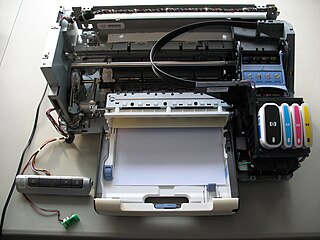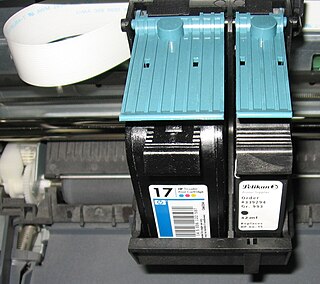
In computing, a printer is a peripheral machine which makes a durable representation of graphics or text, usually on paper. While most output is human-readable, bar code printers are an example of an expanded use for printers. Different types of printers include 3D printers, inkjet printers, laser printers, and thermal printers.

Dot matrix printing, sometimes called impact matrix printing, is a computer printing process in which ink is applied to a surface using a relatively low-resolution dot matrix for layout. Dot matrix printers are a type of impact printer that prints using a fixed number of pins or wires and typically use a print head that moves back and forth or in an up-and-down motion on the page and prints by impact, striking an ink-soaked cloth ribbon against the paper. They were also known as serial dot matrix printers. Unlike typewriters or line printers that use a similar print mechanism, a dot matrix printer can print arbitrary patterns and not just specific characters.

Inkjet printing is a type of computer printing that recreates a digital image by propelling droplets of ink onto paper and plastic substrates. Inkjet printers were the most commonly used type of printer in 2008, and range from small inexpensive consumer models to expensive professional machines. By 2019, laser printers outsold inkjet printers by nearly a 2:1 ratio, 9.6% vs 5.1% of all computer peripherals.

Giclée describes digital prints intended as fine art and produced by inkjet printers. The term is a neologism, ultimately derived from the French word gicleur, coined in 1991 by printmaker Jack Duganne. The name was originally applied to fine art prints created on a modified Iris printer in a process invented in the late 1980s. It has since been used widely to mean any fine-art printing, usually archival, printed by inkjet. It is often used by artists, galleries, and print shops for their high quality printing, but is also used generically for art printing of any quality.

Digital printing is a method of printing from a digital-based image directly to a variety of media. It usually refers to professional printing where small-run jobs from desktop publishing and other digital sources are printed using large-format and/or high-volume laser or inkjet printers.

Seiko Epson Corporation, commonly known as Epson, is a Japanese multinational electronics company and one of the world's largest manufacturers of printers and information- and imaging-related equipment. Headquartered in Suwa, Nagano, Japan, the company has numerous subsidiaries worldwide and manufactures inkjet, dot matrix, thermal and laser printers for consumer, business and industrial use, scanners, laptop and desktop computers, video projectors, watches, point of sale systems, robots and industrial automation equipment, semiconductor devices, crystal oscillators, sensing systems and other associated electronic components.
Kodak Ultima is a brand of photo paper for inkjet printers sold by Eastman Kodak.

A continuous ink system (CIS), also known as a continuous ink supply system (CISS), a continuous flow system (CFS), an automatic ink refill system (AIRS), a bulk feed ink system (BFIS), or an off-axis ink delivery system (OIDS) is a method for delivering a large volume of liquid ink to a comparatively small inkjet printhead. Many business and professional grade printers incorporate a continuous ink system in their design to increase printing capacity.

An ink cartridge or inkjet cartridge is the component of an inkjet printer that contains the ink to be deposited onto paper during printing. It consists of one or more ink reservoirs and can include electronic contacts and a chip to exchange information with the printer.
Personal Printer Data Stream is a general name for a family of page description language used by IBM printers, which includes all Proprinter, Quietwriter, Quickwriter, LaserPrinter 4019, and LaserPrinter 4029 commands.

Blu-ray Disc Recordable (BD-R) and Blu-ray Disc Recordable Erasable (BD-RE) refer to two direct to disc optical disc recording technologies that can be recorded on to a Blu-ray-based optical disc with an optical disc recorder. BD-R discs can only be written to once, whereas BD-RE discs can be erased and re-recorded multiple times, similar to CD-R and CD-RW for a compact disc (CD). Disc capacities are 25 GB for single-layer discs, 50 GB for double-layer discs, 100 GB ("XL") for triple-layer, and 128 GB for quadruple-layer.

Inkjet paper is a special fine paper designed for inkjet printers, typically classified by its weight, brightness and smoothness, and sometimes by its opacity.
ESC/P, short for Epson Standard Code for Printers and sometimes styled Escape/P, is a printer control language developed by Epson to control computer printers. It was mainly used in dot matrix printers and some inkjet printers, and is still widely used in many receipt thermal printers. During the era of dot matrix printers, it was also used by other manufacturers, sometimes in modified form. At the time, it was a popular mechanism to add formatting to printed text, and was widely supported in software.
Direct-to-disc or direct-to-disk may refer to:

Dymo DiscPainter is a CD and DVD printer that prints a user's image or text of choice directly onto the disc, eliminating the need for labels.
C110 or C-110 may represent:

M-DISC is a write-once optical disc technology introduced in 2009 by Millenniata, Inc. and available as DVD and Blu-ray discs.
The Veris printer is a medium format 1500 DPI color inkjet printer manufactured by the Graphic Communications Group of Eastman Kodak, which is used for digital Prepress proofing. A refinement of the Iris printer, the Veris also uses a continuous flow ink system to produce continuous-tone output on specially designed media. Unlike most inkjet printers which fire drops only when needed, the Veris uses eight 10 micrometer glass jets that operate continuously under high pressure, vibrated by a piezoelectric crystal to produce drops at a 1 MHz rate, or 8 million drops per second in total. Drops that are not needed to form the image are deflected electrostatically into a waste collection system, and individual drops can be directed to a specific position on the media. The Veris prints with the same quality of the Iris, only faster because of the larger number of jets.
Kodak Proofing Software is an application from Eastman Kodak for managing and controlling the process of Prepress proofing. It supports the Veris printer, Kodak Approval and various inkjet printers from Epson and Hewlett Packard.
Supertank printers are a type of continuous ink system (CISS) inkjet printer. Supertank printers differ from traditional inkjet printers in that the printhead is connected via a tube system that draws ink from large ink tanks built into the printer, which are filled and refilled via ink bottles, eliminating the need for ink cartridges. Cost-per-page (CPP) is significantly lower than traditional cartridges, as replacement ink bottles contain enough ink to print thousands of pages, and typically cost under $20.










